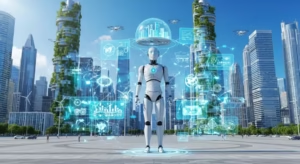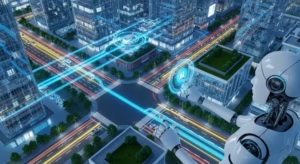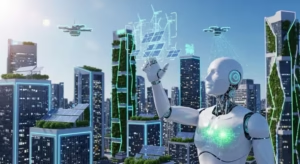The Future of AI in Smart Cities: Building Intelligent Urban Systems

The article examines the transformative role of AI in smart cities, highlighting its potential to enhance urban living. It discusses how AI in smart cities can unlock efficiencies across various sectors, particularly in traffic optimization, where intelligent systems can significantly reduce congestion and improve mobility. Additionally, the use of AI in energy management is explored, underscoring its importance for creating sustainable cities by optimizing resource usage. The future steps for integrating AI in urban planning are also addressed, emphasizing the need for collaborative approaches to build intelligent urban systems. This innovative technology promises to revolutionize urban environments, making them more livable and sustainable.
Unlocking The Potential Of AI In Smart Cities

The integration of AI in smart cities is revolutionizing urban living by enhancing efficiency and improving quality of life. With urban populations projected to increase significantly in the coming decades, the need for innovative solutions to manage urban challenges is more critical than ever. Urban AI harnesses vast amounts of data from various sources, enabling cities to become more responsive and adaptive. Through predictive analytics, cities can anticipate issues such as traffic congestion, waste management, and energy consumption, ultimately mitigating challenges before they escalate.
Key Components Of AI In Smart Cities
- Data Analytics: Utilizing big data to inform decision-making processes.
- Real-time Monitoring: Implementing sensors and IoT devices to track urban systems dynamically.
- Predictive Modeling: Employing AI algorithms to foresee patterns and trends.
- Resource Management: Optimizing the usage of energy, water, and waste disposal systems.
- Public Safety Solutions: Analyzing data to enhance surveillance and emergency response systems.
- Transportation Systems: Introducing smart traffic signals and route planning for better mobility solutions.
- Citizen Engagement Platforms: Facilitating interaction between residents and city officials through apps and platforms.
By focusing on these key components, cities can leverage urban AI to create tailored solutions that address specific needs and promote sustainability. One significant advantage of AI in smart cities is its ability to enhance collaboration among various city departments and stakeholders. Engaging citizens in the development and implementation of intelligent urban systems fosters a sense of ownership and ensures that the solutions cater to the actual needs of the community, ultimately leading to a more resilient and connected urban environment.
Exploring Traffic Optimization Through Intelligent Systems

In the realm of modern urban planning, the integration of AI in smart cities plays a pivotal role in enhancing traffic optimization. Intelligent systems are revolutionizing how we manage traffic flows, reducing congestion, and improving safety. By leveraging real-time data and advanced algorithms, cities can make informed decisions that lead to streamlined traffic management and enhanced smart infrastructure.
As cities expand and populations grow, the demand for efficient transportation systems increases. Advanced technologies now enable traffic optimization by analyzing vast amounts of data from various sources, such as GPS, sensors, and cameras. By employing machine learning algorithms, these systems can predict traffic patterns and adjust signals and routes accordingly to minimize delays and maximize efficiency.
| Technology | Application | Benefits |
|---|---|---|
| AI Traffic Management Systems | Real-time traffic signal adjustment | Reduced wait times and congestion |
| Connected Vehicle Technology | Vehicle-to-Infrastructure communication | Improved safety and traffic flow |
| Predictive Analytics | Forecasting traffic incidents | Better resource allocation |
| Smart Parking Solutions | Dynamic parking availability | Reduced circling for parking |
Incorporating these technologies effectively requires a structured approach. Below are key steps to ensure successful implementation of traffic optimization systems within smart cities:
Steps For Implementing Traffic Optimization
- Analyze current traffic patterns and infrastructure capabilities.
- Identify key technologies that align with city goals.
- Engage stakeholders, including city planners and community members.
- Create a pilot program to test the technology.
- Evaluate the pilot’s success and gather data for improvements.
- Implement fully integrated systems across the city.
- Establish ongoing monitoring and adjustment protocols.
Technologies In Traffic Optimization
Several emerging technologies are driving the transformation of traffic management systems. Systems built on AI leverage data analytics to provide insights and actionable solutions, significantly enhancing overall urban mobility. Implementations of intelligent traffic control systems not only improve efficiency but also foster a seamless experience for commuters, which is essential in busy urban environments.
Case Studies Of Successful Implementations
Across the globe, cities that have adopted intelligent traffic systems have reported remarkable outcomes. For instance, cities like Los Angeles and Singapore have successfully implemented AI-driven traffic optimization strategies, resulting in noticeable reductions in congestion and commute times. These case studies illustrate the potential of smart infrastructure and its impact on urban living, paving the way for the future of sustainable and efficient cities.
Harnessing Energy Management AI For Sustainable Cities

Energy management AI plays a pivotal role in the evolution of smart cities, driving solutions that optimize energy consumption while minimizing waste. As urban environments continue to grow, the integration of artificial intelligence in energy systems is essential to ensure that cities remain sustainable and efficient. With the capability to analyze vast amounts of data in real-time, energy management AI helps city planners and utilities better understand energy patterns, allowing for adjustments that lead to significant reductions in carbon emissions and enhanced overall productivity.
Benefits Of Energy Management AI
- Enhanced Efficiency: AI-powered systems can optimize energy use across various infrastructures.
- Cost Savings: By predicting energy demand, cities can reduce operational costs.
- Improved Reliability: Continuous monitoring helps in identifying and rectifying issues before they escalate.
- Environmental Impact: Reduction in energy consumption leads to lower carbon footprints.
- Data-Driven Decisions: Energy management systems provide actionable insights for urban planners.
- Integration with Smart Infrastructure: AI can seamlessly connect various systems for cohesive energy management.
Moreover, the utilization of energy management AI enables cities to implement renewable energy sources more effectively. By forecasting energy availability and demand, cities can intelligently deploy solar, wind, and other renewable systems, fostering a balanced energy grid. This intelligent approach not only facilitates a smoother transition to greener alternatives but also enhances energy resilience, preparing urban environments for future challenges related to climate change.
Smart infrastructure, powered by AI, is crucial for future-ready urban spaces, ensuring sustainable growth and efficiency.
As cities harness the capabilities of energy management AI, they create a blueprint for sustainable living that other regions can emulate. This transition is not merely about technology; it represents a holistic change in how urban areas engage with their energy systems. By prioritizing sustainability through AI, cities can not only improve their operational efficiencies but also enhance the quality of life for their residents, making urban spaces healthier, cleaner, and more enjoyable to live in.
Future Steps For Integrating AI In Urban Planning

As urbanization accelerates, the integration of AI in smart cities becomes increasingly crucial. Innovations in urban AI not only enhance efficiency but also improve the quality of life for residents. To successfully harness the potential of AI in urban planning, it is essential to adopt a multi-faceted approach that addresses various aspects of city management, infrastructure development, and citizen engagement.
Actionable Steps For Urban Development
- Establish collaborations between governments, tech companies, and local communities.
- Invest in state-of-the-art data collection technologies to support informed decision-making.
- Develop comprehensive AI strategies that align with urban planning goals.
- Implement pilot projects to test AI applications in real-world settings.
- Facilitate public education initiatives to raise awareness about urban AI benefits.
- Create regulatory frameworks that ensure ethical AI use in urban environments.
- Continuously monitor and evaluate AI systems to adapt to changing urban needs.
By following these actionable steps, cities can effectively navigate the complexities associated with urban planning in the context of emerging technologies. The seamless integration of AI will pave the way for smarter, more resilient urban environments, ultimately fostering a sustainable future. Furthermore, stakeholders must remain vigilant and adaptable to the ongoing advancements in urban AI, ensuring that cities not only meet current demands but also anticipate future challenges.
Briefing Document: The Future of AI in Smart Cities
I. Executive Summary
This briefing document reviews the transformative potential of Artificial Intelligence (AI) in smart cities, highlighting its crucial role in enhancing urban living, efficiency, and sustainability. The integration of AI in urban planning and management is presented as a revolutionary step towards creating more livable, resilient, and connected urban environments. Key themes include AI’s application in traffic optimization, energy management, and citizen engagement, all underpinned by data analytics, real-time monitoring, and predictive modeling. The document also outlines future steps for successful AI integration, emphasizing collaboration, ethical considerations, and continuous adaptation.
II. Main Themes and Most Important Ideas/Facts
1. Transformative Role of AI in Urban Living and Efficiency
AI is positioned as a critical tool for revolutionizing urban environments by significantly improving efficiency and quality of life. As urban populations continue to grow, AI offers “innovative solutions to manage urban challenges.”
- Overall Goal: AI “promises to revolutionize urban environments, making them more livable and sustainable.”
- Data-Driven Solutions: “Urban AI harnesses vast amounts of data from various sources, enabling cities to become more responsive and adaptive.” This includes using “predictive analytics” to anticipate and mitigate issues like “traffic congestion, waste management, and energy consumption.”
- Key Components of AI in Smart Cities:
- Data Analytics: “Utilizing big data to inform decision-making processes.”
- Real-time Monitoring: “Implementing sensors and IoT devices to track urban systems dynamically.”
- Predictive Modeling: “Employing AI algorithms to foresee patterns and trends.”
- Resource Management: “Optimizing the usage of energy, water, and waste disposal systems.”
- Public Safety Solutions: “Analyzing data to enhance surveillance and emergency response systems.”
- Transportation Systems: “Introducing smart traffic signals and route planning for better mobility solutions.”
- Citizen Engagement Platforms: “Facilitating interaction between residents and city officials through apps and platforms.”
- Enhanced Collaboration: AI facilitates “collaboration among various city departments and stakeholders,” fostering “a sense of ownership” and ensuring solutions meet community needs.
2. AI for Traffic Optimization and Smart Infrastructure
AI plays a pivotal role in enhancing urban mobility by optimizing traffic flow, reducing congestion, and improving safety. This is achieved through intelligent systems that leverage real-time data and advanced algorithms.
- Problem Addressed: The increasing demand for efficient transportation systems due to expanding cities and growing populations.
- Mechanism: AI systems “analyze vast amounts of data from various sources, such as GPS, sensors, and cameras” and “employ machine learning algorithms” to predict traffic patterns and adjust signals and routes.
- Benefits:
- AI Traffic Management Systems: “Real-time traffic signal adjustment” leads to “Reduced wait times and congestion.”
- Connected Vehicle Technology: “Vehicle-to-Infrastructure communication” results in “Improved safety and traffic flow.”
- Predictive Analytics: “Forecasting traffic incidents” enables “Better resource allocation.”
- Smart Parking Solutions: “Dynamic parking availability” leads to “Reduced circling for parking.”
- Implementation Steps: A structured approach is required, including analyzing current patterns, identifying key technologies, engaging stakeholders, conducting pilot programs, evaluating success, implementing integrated systems, and establishing ongoing monitoring.
- Successful Implementations: Cities like Los Angeles and Singapore have demonstrated “noticeable reductions in congestion and commute times” through AI-driven traffic optimization, illustrating the “potential of smart infrastructure.”
3. Harnessing Energy Management AI for Sustainable Cities
Energy management AI is crucial for creating sustainable and efficient urban environments by optimizing energy consumption and minimizing waste.
- Central Role: “Energy management AI plays a pivotal role in the evolution of smart cities, driving solutions that optimize energy consumption while minimizing waste.”
- Real-time Analysis: AI can “analyze vast amounts of data in real-time” to help planners understand energy patterns and make adjustments, leading to “significant reductions in carbon emissions and enhanced overall productivity.”
- Benefits of Energy Management AI:
- Enhanced Efficiency: “AI-powered systems can optimize energy use across various infrastructures.”
- Cost Savings: “By predicting energy demand, cities can reduce operational costs.”
- Improved Reliability: “Continuous monitoring helps in identifying and rectifying issues before they escalate.”
- Environmental Impact: “Reduction in energy consumption leads to lower carbon footprints.”
- Data-Driven Decisions: “Energy management systems provide actionable insights for urban planners.”
- Integration with Smart Infrastructure: “AI can seamlessly connect various systems for cohesive energy management.”
- Renewable Energy Integration: AI enables more effective deployment of renewable energy sources by “forecasting energy availability and demand,” fostering a “balanced energy grid” and enhancing “energy resilience.”
- Holistic Change: This transition represents “a holistic change in how urban areas engage with their energy systems,” leading to healthier, cleaner, and more enjoyable urban spaces.
4. Future Steps and Challenges in AI Integration
Successful integration of AI in urban planning requires a multi-faceted approach focusing on collaboration, data, ethical frameworks, and continuous adaptation.
- Multi-Faceted Approach: “To successfully harness the potential of AI in urban planning, it is essential to adopt a multi-faceted approach that addresses various aspects of city management, infrastructure development, and citizen engagement.”
- Actionable Steps for Urban Development:
- Collaboration: “Establish collaborations between governments, tech companies, and local communities.”
- Investment in Data: “Invest in state-of-the-art data collection technologies to support informed decision-making.”
- Strategic Development: “Develop comprehensive AI strategies that align with urban planning goals.”
- Pilot Projects: “Implement pilot projects to test AI applications in real-world settings.”
- Public Education: “Facilitate public education initiatives to raise awareness about urban AI benefits.”
- Regulatory Frameworks: “Create regulatory frameworks that ensure ethical AI use in urban environments.”
- Continuous Monitoring: “Continuously monitor and evaluate AI systems to adapt to changing urban needs.”
- Adaptability: Stakeholders “must remain vigilant and adaptable to the ongoing advancements in urban AI,” ensuring cities meet current demands and “anticipate future challenges.”
The integration of AI in smart cities represents a profound shift in urban management, promising enhanced efficiency, sustainability, and quality of life. From optimizing traffic flow and revolutionizing energy management to fostering greater citizen engagement, AI is set to redefine urban environments. Realizing this potential requires a collaborative, data-driven, and ethically sound approach, with continuous adaptation to emerging technologies and evolving urban needs.
Artificial intelligence / humanaifuture
For similar articles, please visit: AI in Science & Technology
🎧 Listen to the Podcast
Want to explore this topic in more depth? Listen to the full podcast for more insights and expert commentary.
▶️ Play on Google DriveNo sign-up needed — just click and listen.
What are the key components of AI in smart cities?
The key components of AI in smart cities include:
- Data Analytics: Utilizing big data to inform decision-making processes.
- Real-time Monitoring: Implementing sensors and IoT devices to track urban systems dynamically.
- Predictive Modeling: Employing AI algorithms to foresee patterns and trends.
- Resource Management: Optimizing the usage of energy, water, and waste disposal systems.
- Public Safety Solutions: Analyzing data to enhance surveillance and emergency response systems.
- Transportation Systems: Introducing smart traffic signals and route planning for better mobility solutions.
- Citizen Engagement Platforms: Facilitating interaction between residents and city officials through apps and platforms. These components enable cities to create tailored solutions that address specific needs and promote sustainability.
How does AI contribute to traffic optimization in smart cities?
AI plays a pivotal role in enhancing traffic optimization by leveraging real-time data and advanced algorithms. Intelligent systems analyze data from GPS, sensors, and cameras to predict traffic patterns and adjust signals and routes accordingly. This leads to reduced wait times and congestion, improved safety, and better resource allocation. Technologies like AI Traffic Management Systems, Connected Vehicle Technology, Predictive Analytics, and Smart Parking Solutions are essential for streamlined traffic management and enhanced smart infrastructure.
What are the benefits of using AI for energy management in smart cities?
Energy management AI is crucial for creating sustainable and efficient cities. Its benefits include:
- Enhanced Efficiency: Optimizing energy use across various infrastructures.
- Cost Savings: Reducing operational costs by predicting energy demand.
- Improved Reliability: Continuous monitoring helps identify and rectify issues.
- Environmental Impact: Lowering carbon footprints through reduced energy consumption.
- Data-Driven Decisions: Providing actionable insights for urban planners.
- Integration with Smart Infrastructure: Seamlessly connecting various systems for cohesive energy management. AI also facilitates the effective integration of renewable energy sources, fostering a balanced and resilient energy grid.
How does AI help in creating sustainable cities?
AI contributes to sustainable cities primarily through optimized resource management and environmental impact reduction. By analyzing energy patterns in real-time, energy management AI helps cities significantly reduce carbon emissions and enhance overall productivity. It enables more effective deployment of renewable energy sources and improves energy resilience. Additionally, by optimizing traffic flow and managing waste, AI reduces the environmental footprint of urban areas, making them healthier and cleaner.
What steps are necessary for integrating AI into urban planning?
Successfully integrating AI into urban planning requires a multi-faceted approach, including:
- Establishing collaborations between governments, tech companies, and local communities.
- Investing in state-of-the-art data collection technologies.
- Developing comprehensive AI strategies aligned with urban planning goals.
- Implementing pilot projects to test AI applications in real-world settings.
- Facilitating public education initiatives to raise awareness about AI benefits.
- Creating regulatory frameworks to ensure ethical AI use.
- Continuously monitoring and evaluating AI systems to adapt to changing urban needs.
Can you provide examples of cities successfully implementing AI for traffic optimization?
Yes, cities across the globe have reported remarkable outcomes from adopting intelligent traffic systems. For instance, Los Angeles and Singapore have successfully implemented AI-driven traffic optimization strategies. These initiatives have led to noticeable reductions in congestion and commute times, illustrating the significant potential of smart infrastructure and its positive impact on urban living.
What is the long-term vision for AI in smart cities?
The long-term vision for AI in smart cities is to create smarter, more resilient urban environments that foster a sustainable future. This involves not only enhancing operational efficiencies but also improving the quality of life for residents, making urban spaces healthier, cleaner, and more enjoyable. AI is expected to revolutionize urban environments by enabling cities to become more responsive, adaptive, and prepared for future challenges, especially those related to climate change and growing urban populations.




